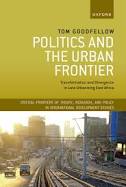Politics and the Urban Frontier: Transformation and Divergence in Late Urbanizing East Africa

Tom Goodfellow’s volume is part of the official book series of the Development Studies Association of the UK, ‘Critical Frontiers of Theory, Research, and Policy in International Development Studies.’ It is a culmination of 15 years of research that began with the author’s PhD studies and progressed through a number of collaborative projects.
This book is broken into four parts and offers a comprehensive comparative study of three cities in East Africa. Goodfellow argues that we should be learning from the experiences of intense urbanization occurring within the region of East Africa, referred to as the ‘world’s most vital urban laboratory’ (p.283). The opening section, ‘Impressions’, uses a diary entry format to give the reader first-person experiences of interactions in the capital cities of Rwanda, Uganda and Ethiopia between 2009 and 2019.
Part 1, titled ‘Urban Tectonics’, contains the first two chapters. Chapter 1 expounds upon the regional focus of East Africa used within the book and contends that a close consideration of different analytical scales can produce insight into both regional urban trends and differing trajectories of urban development between the region’s countries and cities. The premise of the book’s argument is that if we are to work towards better urban futures, we need to understand how shared global and regional processes can produce diverse urban trajectories. Chapter 2 presents the book’s analytical framework, which is designed to advance the methods available for analysing the drivers of urban change. The framework uses four overarching causal factors to explore the similarities and divergences between the urban trajectories of Kampala, Kigali and Addis Ababa. These causal factors are the distribution of associational power; the pursuit of social legitimacy; modalities of political informality; and infrastructural reach.
Goodfellow uses Part 2 of the book, titled ‘Urban Foundations’, to explore the historical experiences that influenced the origins of the cities he is investigating. Chapter 3 moves from the precolonial period through to the period since the 1980s and 1990s to understand how notions of territory and property in land have shaped the evolution of capital cities in East Africa. Chapter 4 follows on to demonstrate how East African cities were shaped by the politics of capital and labour as well as the politics of land. This chapter explores the different economic structures in urban Rwanda, Uganda and Ethiopia, providing the necessary historical foundations for the analysis of contemporary urban conditions in part three of the book.
That third part, titled ‘Urban Currents’, applies the book’s analytical framework across four key areas: (Chapter 5) the deployment of urban planning visions and major urban infrastructure projects; (Chapter 6) the patterns of property development and housing provision; (Chapter 7) attempts to reshape urban marketplaces and regulate petty trade; and (Chapter 8) the ways in which the urban populations have responded to the changes in these areas through different registers of political mobilization. The chapters weave between projects and events in Kampala, Kigali and Addis Ababa in the early twenty-first century, highlighting the regional dimension of the urban transformations in these areas as well as the differences between them. The rich description of political dynamics and socio-economic changes in these cities provides layers of context that build upon one another.
The fourth and final part of the book, ‘Conclusions’, reviews the book’s key findings. The empirical chapters in Part 3 demonstrate the ways in which the three cities under investigation have a ‘regionally specific relationship to contemporary global capitalism’ (p.270) but have also explored different forms of property and territory, leading to different types of relations between state and society. The benefits of using political analysis as opposed to the dynamics of capital alone to understand these diverging trajectories of urban development is demonstrated. Chapter 9 concludes by reflecting on the capacity and agency of societies in East Africa’s cities to forge their own paths through late urbanization, as well as the lessons to be learnt from these experiences about the political inclusion that we should be working towards in our urban futures.
Book Note prepared by Isis Barei-Guyot.
Search the Book notes database
Our Book notes database contains details and summaries of all the publications included in Book notes since 1993 - with details on how to obtain/download.
Use the search form above, or visit the Book notes landing page for more options and latest content.
For a searchable database for papers in Environment and Urbanization, go to http://eau.sagepub.com/

